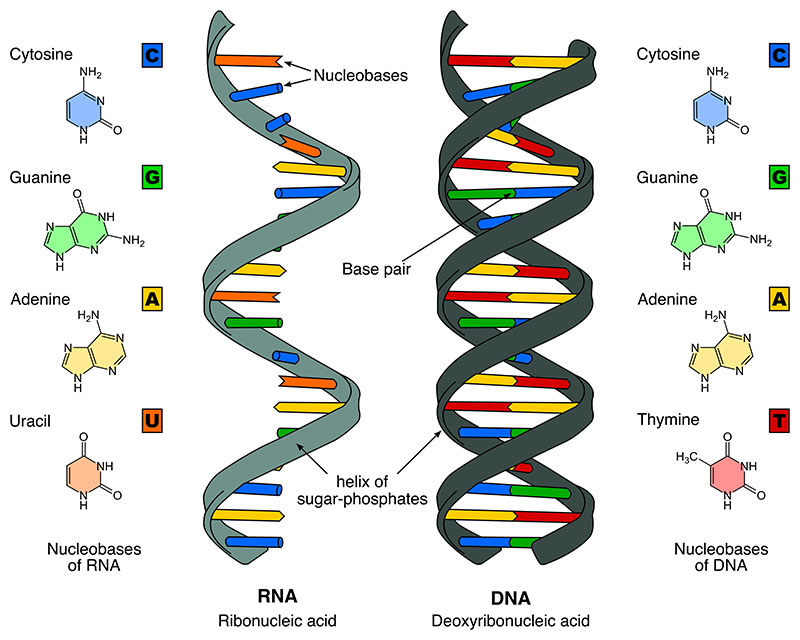Base Pair: The Building Blocks of DNA and RNA
What is a Base Pair?
A base pair is a fundamental unit of double-stranded nucleic acids, such as DNA and RNA. It consists of two complementary nucleobases bound to each other by hydrogen bonds. The base pairing rules state that adenine (A) pairs with thymine (T) or uracil (U), while guanine (G) pairs with cytosine (C). These base pairs form the rungs of the DNA or RNA ladder, with the sugar-phosphate backbone forming the sides.

Types of Base Pairs
There are two main types of base pairs found in nucleic acids:
Watson-Crick Base Pairs
The most common type of base pairing is the Watson-Crick base pair, named after James Watson and Francis Crick, who first proposed the double helix structure of DNA. In this type of pairing, adenine (A) forms two hydrogen bonds with thymine (T) in DNA or uracil (U) in RNA, while guanine (G) forms three hydrogen bonds with cytosine (C). These base pairs are highly specific and stable, ensuring the accurate replication and transcription of genetic information.
Non-Watson-Crick Base Pairs
In addition to the standard Watson-Crick base pairs, there are also non-canonical base pairs that can form in certain situations. These include wobble base pairs, such as G-U and I-A (inosine-adenine), which have a slightly different geometry and hydrogen bonding pattern. Non-Watson-Crick base pairs can play important roles in RNA secondary structure, protein-nucleic acid interactions, and genetic recoding events.
The Role of Base Pairs in Genetics
Base pairs play a crucial role in the storage, transmission, and expression of genetic information. The sequence of base pairs in DNA determines the genetic code, which is read in triplets (codons) to specify the amino acid sequence of proteins. The complementary nature of base pairing allows for the accurate replication of DNA during cell division and the transcription of DNA into RNA for protein synthesis.
Base Pairs and DNA Structure
The base pairing interactions between the complementary nucleobases contribute to the overall structure and stability of the DNA double helix. The hydrogen bonds between the base pairs, along with the stacking interactions between adjacent base pairs, help maintain the helical structure of DNA. The width of the double helix is uniform, with a diameter of approximately 2 nanometers, and the distance between adjacent base pairs is 0.34 nanometers.
Mutations and Base Pair Changes
Mutations in DNA can arise from changes in the base pair sequence, such as substitutions, insertions, or deletions of nucleotides. These mutations can have various effects on the function of genes and the proteins they encode. For example, a point mutation that changes a single base pair can lead to a missense mutation, where a different amino acid is incorporated into the protein, or a nonsense mutation, where a premature stop codon is introduced. Insertions or deletions of base pairs can shift the reading frame and disrupt the proper translation of the genetic code.
Techniques for Studying Base Pairs
Several techniques are used to study base pairs and their interactions in nucleic acids:
- X-ray Crystallography: This technique allows for the determination of the three-dimensional structure of DNA or RNA molecules at atomic resolution, revealing the precise arrangement of base pairs and the overall helical structure.
- Nucleic Acid Hybridization: This method involves the formation of base pairs between complementary single-stranded DNA or RNA molecules, which can be used to detect specific sequences, assess sequence similarity, or quantify gene expression.
- Footprinting Assays: These assays, such as DNase I footprinting or chemical probing, can identify protein binding sites or other interactions that protect specific base pairs from enzymatic or chemical cleavage.
Applications of Base Pair Knowledge
Understanding the properties and interactions of base pairs has numerous applications in biotechnology and related fields:
- Primer Design: Knowledge of base pairing rules is essential for designing primers for polymerase chain reaction (PCR), a widely used technique for amplifying specific DNA sequences.
- DNA Sequencing: The complementary nature of base pairing is exploited in DNA sequencing technologies, such as Sanger sequencing and next-generation sequencing, to determine the order of nucleotides in a DNA molecule.
- Gene Therapy: Base pairing interactions are utilized in the design of antisense oligonucleotide and small interfering RNAs (siRNAs) for targeted gene silencing in therapeutic applications.
- DNA Nanotechnology: The predictable and programmable nature of base pairing is harnessed in DNA nanotechnology to create complex nanostructures and devices, such as DNA origami and DNA-based molecular machines.
Further Reading
Current Opinion in Chemical Biology, Model Systems for Understanding DNA Base Pairing
Computational and Structural Biotechnology Journal, Base-pair Opening Dynamics of Nucleic Acids in Relation to Their Biological Function
Chemical Society Reviews, Genetic alphabet expansion technology by creating unnatural base pairs
